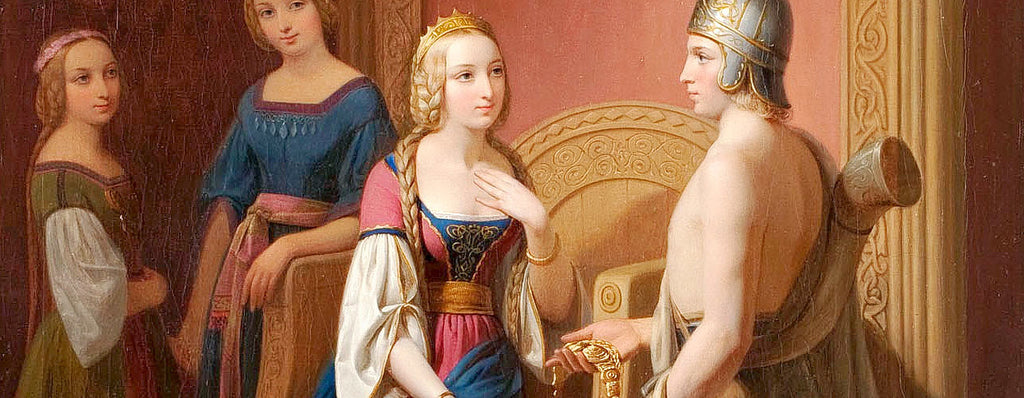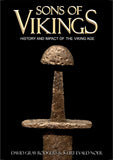The following is our winning 2020 Student Scholarship submission from Grace Traina.
Freya and Aphrodite: comparing the Norse and Greek Goddesses of Love
 Freya, the Norse goddess of love, beauty, fertility and sexuality, bears a striking physical and mythological resemblance to Aphrodite, the Greek goddess of the same domain. I wanted to research Freya to examine the similarities and differences between the Norse and Greek depictions of the most traditionally “beautiful” goddess.
Freya, the Norse goddess of love, beauty, fertility and sexuality, bears a striking physical and mythological resemblance to Aphrodite, the Greek goddess of the same domain. I wanted to research Freya to examine the similarities and differences between the Norse and Greek depictions of the most traditionally “beautiful” goddess.
The relationship between Freya and Frigg (the wife of head god Odin) in Norse mythology is similar to the relationship between Aphrodite and Hera (the wife of head god Zeus) in Greek mythology. Freya and Frigg, like Aphrodite and Hera, are considered the two most beautiful goddesses in their respective canon and are noted for their continuous sexual infidelity. Freya and Frigg each possess magical powers and are “archetypes of the völva, a professional or semiprofessional practitioner of seidr, the most organized form of Norse magic” (“Freya”). However, while Freya and Frigg tend to use their godly powers for more superficial means (i.e. obtaining jewelry and material things), Aphrodite and Hera manipulate their magic for more pragmatic, even cruel, purposes. Aphrodite, for example, punished Hippolytus, a mortal man who refused to worship her, by having his mother fall madly in love with him, a lust that eventually led to his mother’s suicide (“Hippolytus”). The mythological similarity between Freya and Frigg alludes to the lack of emphasis that Norse mythology prescribed to female goddesses.
While Aphrodite and Hera are distinctly separate characters in Greek mythology, Freya and Frigg have a great amount of overlap. Freya and Frigg are married to similar-named men (Oor and Odin respectively), both use bird-of-prey feathers for shapeshifting, and both names are attributed to the Germanic word for “Friday” (“Freya”). Etymologically, both Freya and Frigg are tied closer together. Freya’s name translates directly to “lady,” while Frigg’s name has its root in the word “beloved.” In contrast to Aphrodite and Hera, whose distinct names indicate their distinct mythological realms, both Freya’s and Frigg’s names relate to the same areas of love, femininity, and sexuality. Several scholars assert that Freya and Frigg were “only nominally distinct figures by the late Viking Age” and “were practically the same personage in everything but name” (“Frigg”).
 There are few archaeological or artistic depictions of Freya contemporary to the Viking epoch. The sculptural remnants that have been found are small jewelry pendants or broaches (“Extraordinary Discovery”). Aphrodite, on the other hand, was the subject of classical artistic reverence. Praxiteles’s fourth century B.C. sculpture of Aphrodite of Knidos, depicted the Greek goddess of love as a sacred being, strategically placing her hands to preserve her modesty and sculpting her in her full form, at a height of over five feet (“Statue of”). More recent artistic depictions of Freya, specifically the 1846 painting by Nils Blommér, tend to depict the goddess as gently demure and feminine, ignoring her wild nature prescribed in many Norse myths (See Fig. 1). Jacques-Louis David’s painting Mars Being Disarmed by Venus, conversely depicts Aphrodite as possessing an intense power intertwined with her sexuality (See Fig. 2). Aphrodite, much more so than Freya, was considered by artists, historians, and poets as an integral part of her larger mythology. Freya, in most Norse myths concerning her, plays a mere ornamental role in the background.
There are few archaeological or artistic depictions of Freya contemporary to the Viking epoch. The sculptural remnants that have been found are small jewelry pendants or broaches (“Extraordinary Discovery”). Aphrodite, on the other hand, was the subject of classical artistic reverence. Praxiteles’s fourth century B.C. sculpture of Aphrodite of Knidos, depicted the Greek goddess of love as a sacred being, strategically placing her hands to preserve her modesty and sculpting her in her full form, at a height of over five feet (“Statue of”). More recent artistic depictions of Freya, specifically the 1846 painting by Nils Blommér, tend to depict the goddess as gently demure and feminine, ignoring her wild nature prescribed in many Norse myths (See Fig. 1). Jacques-Louis David’s painting Mars Being Disarmed by Venus, conversely depicts Aphrodite as possessing an intense power intertwined with her sexuality (See Fig. 2). Aphrodite, much more so than Freya, was considered by artists, historians, and poets as an integral part of her larger mythology. Freya, in most Norse myths concerning her, plays a mere ornamental role in the background.
Freya is heavily undeveloped compared to the Norse male characters, especially the male gods. The importance of Freya’s role in many myths results solely from her superficial and sexual appeal. This contrasts the more distinctive role that Greek mythology prescribed its female goddesses and illustrates an underlying difference in the Greek and Norse cultures. Grecian culture, which centered around both warfare and the arts, provided a relatively egalitarian portrayal of male gods versus female goddesses.
Author:
Grace Traina is graduating as first in class from Mandeville High School and will be matriculating at the New York University Stern School of Business Undergraduate College this fall. She is planning on majoring in business with a specialization in economics and a minor in visual arts.
Sons of Vikings is an online store offering hundreds of Viking inspired items, including Viking jewelry, Viking clothing, Drinking horns, home decor items and more.
To learn more about Viking history, we recommend our 400+ page, self titled book that is available here.
Sources:
Blommér, Nils. Heimdall returns the necklace Bryfing to Freya. 1846. Malmö Art Museum, Malmö, Scania.
David, Jacques-Louis. Mars Being Disarmed By Venus. 1824. Musées royaux des Beaux-Arts de Belgique, Brussels.
“Extraordinary Discovery: Does The Revninge-Woman Depict The Goddess Freya?” MessageToEagle.com, 16 Mar. 2016, www.messagetoeagle.com/extraordinary-discovery-revninge-woman-depict-goddess-freya/.
“Freya the Goddess of Love in Norse Mythology.” Norse Mythology, 22 Apr. 2020, norse-mythology.net/freya-the-goddess-of-love-in-norse-mythology/.
“Frigg.” Norse Mythology for Smart People, norse-mythology.org/gods-and-creatures/the-aesir-gods-and-goddesses/frigg/.
“Hippolytus.” Encyclopædia Britannica, Encyclopædia Britannica, Inc., 14 Feb. 2018, www.britannica.com/topic/Hippolytus-Greek-mythology.
“Statue of the Aphrodite of Knidos.” The Art Institute of Chicago, Ancient and Byzantine Art, www.artic.edu/artworks/61600/statue-of-the-aphrodite-of-knidos.
Image Sources:
"Heimdallr returns the necklace Brísingamen to Freyja" (1846) by Nils Blommér.
“Freyja and the Necklace” by James Doyle Penrose (1890).
Nuzzled by her boar Hildisvíni, Freyja gestures to a jötunn in this illustration (1895) by Lorenz Frølich.



Leave a comment: